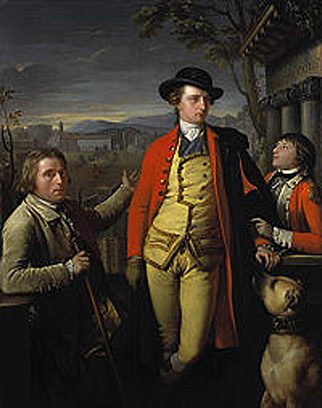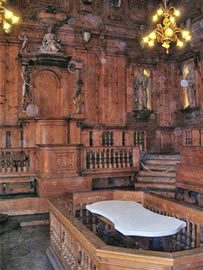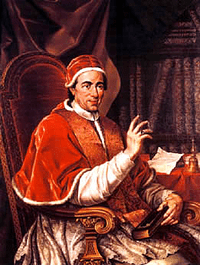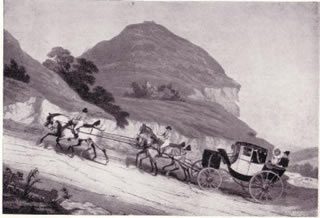Einar Perman
Stockholm, Sweden
In a recent issue of Hektoen International, I wrote about Doctor John Moore’s travels in Europe.1 Moore, a practicing physician in Glasgow with a good reputation, was offered an opportunity to travel. Like other prominent noblemen of his day, the young Duke of Hamilton was to make the Grand Tour as a part of his education. The Duke’s mother knew Moore, and invited him to join the Tour as companion, tutor, and responsible adult. Moore accepted. The Tour lasted five years (1772-1777), and took him to the major European countries.
 |
The 8th Duke of Hamilton with Dr. John Moore and Ensign John Moore, Gavin Hamilton (1723–98). Oil on canvas. Dr. Moore is in the center. The Duke is on his left and his son on his right. In the background can be seen the Campo Vaccino, the Alban Hills and the Temple of Concord in Rome. Reproduced by permission of the National Gallery of Scotland. |
After returning to London, Moore wrote a book about his impressions of France, Switzerland, Germany, and Austria.2 The Tour also included extensive travels in Italy, and the following year in 1779 Moore published a second book called View of Society and Manners in Italy.3 In its foreword he wrote that those who had read his earlier book “will perceive that the present work is a continuation of the former.” In the first book Moore warns the reader not to expect “a minute account of churches and palaces because they afford but a slender entertainment when served up in description.” Instead he concentrated on “the manners, customs, and characters of the people.” The same approach is prominent in this book. It is also written as letters to a fictitious gentleman in England, but this time Moore does not hide under anonymity. This book was a success like its predecessor, and came out in several editions.
The first stop was Venice. With a population of about 150,000, Venice was at this time regarded as the most elegant and refined city in Europe; greatly influencing art, architecture, and literature. Only when Napoleon conquered the city in 1797 did Venice enter its long cultural decline. Moore has high regards for the Venetians. They are “lively, ingenious people, extravagantly fond of public amusements, with an uncommon relish for humour.” Venice had eight or nine theatres including opera houses. Moore admits that he does not enjoy opera. He writes that “the music of the serious operas . . . is in general, infinitely too fine for my ear” and that “it required a considerable effort for me to sit till the end.” He is envious of men who have a real sensibility for music, but for others it is “absurd and silly to affect an excessive delight in things which nature has not framed us to enjoy.”
However, life in Venice also had a dark side. Its population was constantly at the mercy of a despotic judiciary system with two branches: the Council of Ten and the State Inquisitors. These two courts could prosecute and condemn anyone, even the Doge, the chief magistrate, to prison or death on flimsy, anonymous accusations or non-confirmed rumors. Moore is unusually blunt in his conclusions: “There is unquestionably much reflection, and great depth of thought, displayed in the formation of the political constitution . . . but I should admire it much more if the Council of Ten and State Inquisitors, had never formed any part of it” and concludes that “the executive power of Government is as irresistible at Venice, as at Petersburgh or Constantinople.”
 Via Padua the Tour arrived in Ferrara, where Moore notes, “The magnificent streets and numerous fine buildings show that this has been a rich and flourishing city. The present inhabitants, however . . . bear every mark of poverty.” Then the Tour proceeded to Bologna, with six horses to each carriage (instead of four) to overcome the bad roads. The city was governed by a council with 40 members until the Pope increased their numbers to 50. However, they were still called Quaranta because “mankind in general are more alarmed by a change of name . . . than a real change in the nature of things.” Bologna’s major attraction was its university, which offered education in arts and natural sciences. Moore was impressed by its famous anatomical theatre (figure on the right) and its museum of anatomical wax models. There were also professors, who regularly read lectures and instructed students.
Via Padua the Tour arrived in Ferrara, where Moore notes, “The magnificent streets and numerous fine buildings show that this has been a rich and flourishing city. The present inhabitants, however . . . bear every mark of poverty.” Then the Tour proceeded to Bologna, with six horses to each carriage (instead of four) to overcome the bad roads. The city was governed by a council with 40 members until the Pope increased their numbers to 50. However, they were still called Quaranta because “mankind in general are more alarmed by a change of name . . . than a real change in the nature of things.” Bologna’s major attraction was its university, which offered education in arts and natural sciences. Moore was impressed by its famous anatomical theatre (figure on the right) and its museum of anatomical wax models. There were also professors, who regularly read lectures and instructed students.
The Tour continued to Ancona, and over the Appenines. In due course they crossed the Campania and saw Rome, “the ancient Mistress of the World raise her head in melancholy majesty” in the midst of deserted fields. At this time Rome had about the same population as Vienna and Berlin. “by information that I have the greatest reliance on . . . the number of inhabitants at present is about one hundred seventy thousand.”
Like many travelers before him, Moore was overwhelmed by Rome. The mornings were spent visiting its famous antiquities, guided by a man with great qualifications: Mr. Byrnes, a gentleman of probity, knowledge and real taste. In the afternoon they spent two to three hours in conversaziones. These were held in many palaces, and open to prominent citizens and visitors. People assembled in large rooms, where they enjoyed informal discussions, gossip and light refreshments (coffee, lemonade and iced confections of various kinds). Men could come alone, but a woman was always escorted by a man. Her escort was called Cavaliero Servente and could be a relative or a lover—but never her husband: “Familiarities between husband and wife were connived provided they were carried on in private; but for a man to be seen hand in hand with his wife, in public, would not be tolerated . . .” O tempora o mores!
Moore offers an opinion of the national character of the Italians, just as he had done in other countries. He first points out, however, that opinions of national characters are often unfavorable. People think that “those who think and act in a manner opposite to themselves must be either knaves, fools or both.” Admitting his limited experience Moore writes that the Italians “are an ingenious, sober people, with quick feelings, and therefore irritable; but when unprovoked, of a mild and obliging disposition, and less subject to avarice, envy and repining at the narrowness of their own circumstances, and the comparative wealth of others, than most other nations.”
 Pope Clemens XIV (figure on the left) occupied the Holy Chair. Moore gives a vivid description of his dress and person, and although “the papal uniforms are by no means calculated to set off the person to great advantage . . . his present Holiness is not insensible of the charms of his person, or unsolicitous about his external ornaments.” Also he could not “be deaf to the voices of the women who break out in exclamations . . . when he appears in public.”
Pope Clemens XIV (figure on the left) occupied the Holy Chair. Moore gives a vivid description of his dress and person, and although “the papal uniforms are by no means calculated to set off the person to great advantage . . . his present Holiness is not insensible of the charms of his person, or unsolicitous about his external ornaments.” Also he could not “be deaf to the voices of the women who break out in exclamations . . . when he appears in public.”
The Tour was invited to be introduced to the Pope in his private apartment. The Vatican Protocol demanded that each visitor should kiss the Pope’s sacred slipper. Since they were not Catholics, the British Ambassador had negotiated that a deep bow would be acceptable. The young Duke of Hamilton protested “I look on kissing the toe as the only amusing circumstance of the whole; if that is to be omitted I will not be introduced at all.” At the audience the Duke bowed deeply and kissed the slipper. This pleased the Pope so much that he sent the Duke two medals of himself, one of gold, the other of silver.
Considering the limitations the Pope has to accept in his personal life Moore writes, “Nothing can afford a stronger proof of the strength and perseverance of man’s passion for sovereign power, than our knowledge, that even this ecclesiastical crown is sought after with as much eagerness, perhaps with more than any crown in the world.”
After Rome, the Tour continued to the Kingdom of Naples. After praising the beauty of its situation, Moore writes that “there is not, perhaps, a city in the world with the same number of inhabitants, in which so few contribute to the wealth of the community by useful, or by productive labour . . . but the number of priests, monks, fiddlers, lawyers, nobility, footmen and lazzaronis (unemployed, homeless men) surpass all reasonable proportion . . .”
The evenings at the Corso by the waterfront were famous for their opulence and splendor. Colorfully dressed running footmen preceded beautiful, gilt-painted carriages drawn by lavishly decorated horses, and followed by servants in rich liveries. The footmen and servants were usually “the handsomest young men that can be procured.”
But Moore was also aware of the darker side of Naples, and speaks with empathy of the plight of the lazzaronis in Naples: “[L]et the prince be distinguished by splendour and magnificence; let the great and the rich have their luxuries; but in the name of humanity, let the poor, who are willing to labour, have food in abundance to satisfy the cravings of nature, and raiment (clothes) to defend them from the inclemencies of the weather.”
Direct observations and comments on medical matters are few. However, one letter (no LXII. Observations on the pulmonary consumption) deals with tuberculosis, doctors and patients. Moore begins by expressing concern for a sick friend—and his choice of doctor. He writes that “the doctor has employed his mind so entirely in medical researches that he scarcely displays a grain of common sense.” Moore does not deny that such men can make fortunes, only that they are not very likely to cure diseases. Regarding pulmonary consumption Moore states that “people with a fair complexion, delicate skin, slender make, long neck, narrow chest” are predisposed. It was a common disease and the prognosis usually pessima. Moore takes its symptoms (hemoptysis, pleuritis, tubercles in the lung, etc.) to be its cause. His understanding of pulmonary tuberculosis was that of his time, about one hundred years before the advent of bacteriology.
Nearby, Pompei had been discovered 25 years earlier and was slowly being excavated. Only one street and a few detached buildings had been cleared.
On the way back the Tour visited Tivoli. They admired its high waterfalls and the ruins of the enormous villa of Emperor Hadrian. Moore recommends a visit, but not with a big party “and be sure to put your Horatio in your pocket.” Horace has written much about Tivoli, and had a farm nearby, close to his great patron Maecenas.
Next came Florence. It is easy to agree with Moore that it “is unquestionably a very beautiful city” Moore praises the architecture of the houses, streets, quays, and bridges. He points out that the people were fortunate to have to pass the bridges over the Arno constantly and so enjoy its beauty, since both sides of the river are important parts of the city: “In London whose rivers and bridges are far superior . . . people may live whole seasons . . . without ever seeing the Thames” unless they go to South London “on purpose.”
It is also easy to agree that Michelangelo, Bandinelli, Giovanni di Bologna, and Benvenuto Cellini are some of “the best modern masters,” if you remember that their works were much more recent than the classical sculptures. Curiously there is no mention of David, now regarded as one of Michelangelo’s two most famous sculptures.
Via Modena they arrived in Parma, which then had the largest theatre in Europe. Then they proceeded to Milan where he writes of its cathedral, that “no church in Christendom is so much loaded, I had almost said disfigured, with ornaments.” Milan at this time was under Austrian rule. The regime was popular, and the city appeared to thrive.

After Milan they passed Turin, and crossed over into France via a pass at Mount Cenis. This was the preferred route between Italy and France. The pass was over 2000 meters high and had no road (Napoleon built one 1803-1809). The passage was accomplished by taking apart the carriages and having locals carry the pieces and all other items, while the Duke and his companions were carried in Alpian chairs by local chairmen. On the French side the carriages were reassembled and the journey continued. Moore heard that one of the chairmen was getting married the same evening and asked the young man if he was very fond of his mistress. He answered that he had better be, because he had to give thirty livres to the priest for marrying them. This leads Moore to write “To tax matrimony, and oblige the people who beget and maintain children to pay to those who maintain none seems bad policy.”
Moore’s last letter is from Paris. In it Moore writes about the advantages a young Englishman is likely to reap from a tour abroad. These include:
Seeing mankind more at large in numberless situations,
Being able to correct the theoretical notions he may have formed of human nature,
Observing various religions, laws and governments in action, and forming a juster estimate of their value,
Seeing natives of other countries not as he sees them in England, as mere idle spectators, but busily employed,
Learning to distinguish the real from the ostensible motive of men´s words and behaviour,
Developing friendships extending beyond the limits of his own country, and
Perceiving that the blessings and advantages which his countrymen enjoy do not flow from their superiority in wisdom, courage or virtue over other nations, but from those just and equitable laws which secure property, protects its meanest subjects and leaves the mind of man to its own exertions.
Notes
- John Moore, MD: Physician, Travel Writer, and Social Commentator. Hektoen International, Vol.3, April 2009
- Moore, John. A view of society and manners in France, Switzerland and Germany. London, Strahan and Cadell, 1779.
- Moore, John. A view of society and manners in Italy. London, Strahan and Cadell, 1780.
EINAR PERMAN MD, PhD, is a retired physician living in Stockholm, Sweden. He is a member of our international editorial board.
Highlighted in Frontispiece Fall 2009- Volume 1, Issue 5
Fall 2009 | Sections | Travel

Leave a Reply